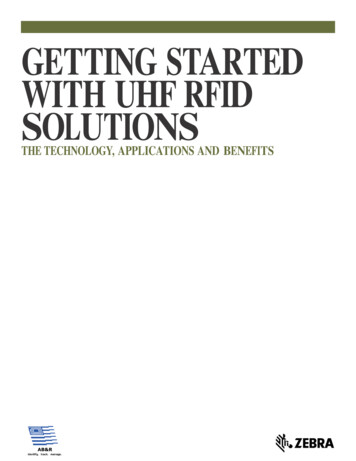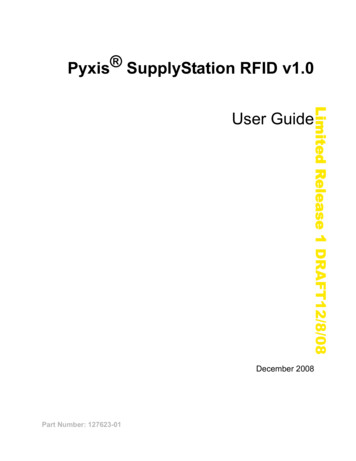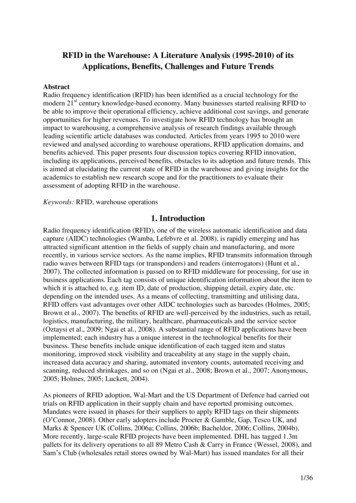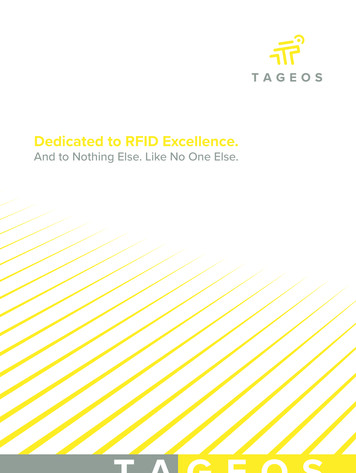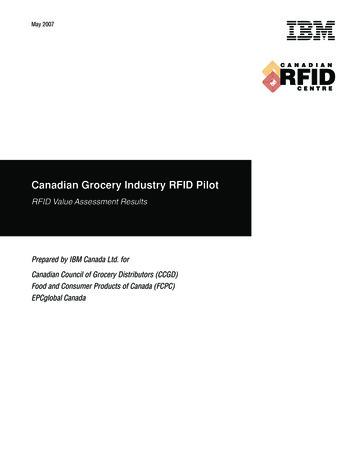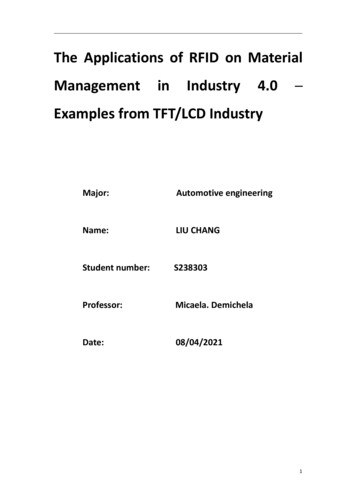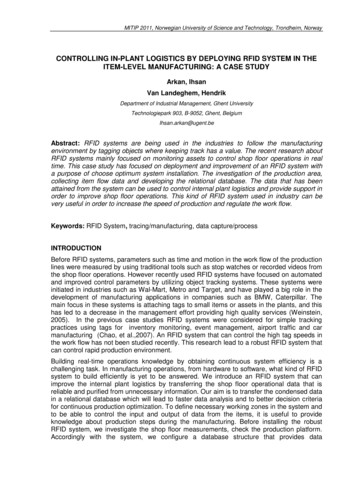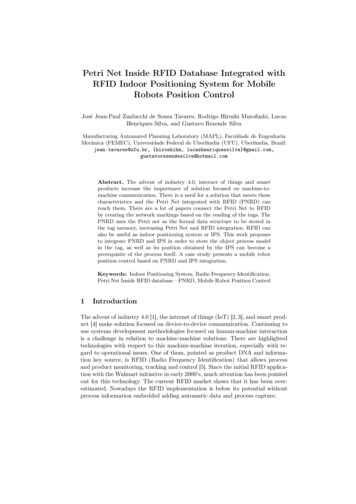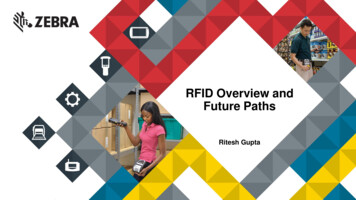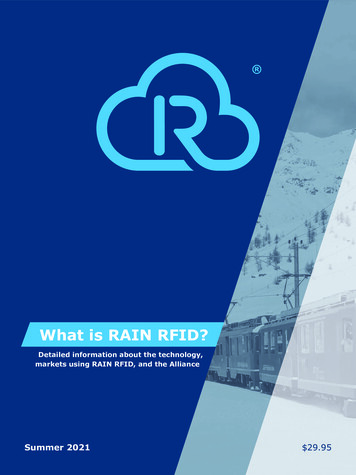
Transcription
What is RAIN RFID?Detailed information about the technology,markets using RAIN RFID, and the AllianceSummer 2021 29.95
DESKTOPSLAPTOPSSERVERSPRINTERSAV E Q U I PIT Assets are critical to everyorganization.But manually inventorying and tracking them is time-consumingand prone to human error.ltemAware is intuitive software that automatically tracks assetlocation, stores asset data and history, and sends you updates.Why does it matter?The US Patent and Trademark Office is now saving 1.2M dollarsevery year by tracking their IT assets with ItemAware.Theft has been virtually eliminated and money is saved by makingsure usage of current assets is at 100% before buying more.How does it work? Collects data from tagged assets Tracks location, status, history,parent/child relationships and more Analyzes asset data Sends alerts based on user rules Runs inventory reports with easydownload features Is easy to use and learnTechnology Agnosticwww.awareinnovations.com2 Mobile Secureinfo@awareinnovations.com Reliable 1 937.528.5858RAIN RFID E-BOOK
TABLE OF CONTENTS4INTRODUCTION5WHAT IS RAIN?6WIRELESS TECHNOLOGIES6DIFFERENT TYPES OF RFID7RFID SYSTEM FREQUENCY RANGES9EU FREQUENCY REGULATION UPDATE10PASSIVE VS ACTIVE10RAIN READER COMMUNICATIONINTERFACE (RCI)12RAIN RFID STARTER KIT14MARKETS / INDUSTRIES /APPLICATIONS3716Animal Identification17Asset Tracking21Aviation22Electronic Vehicle Identification (EVI)24Healthcare27Internet of Things (IoT)33Retail35Smart Manufacturing36Intelligent PackagingRAIN RFID TECHNOLOGY41RAIN RFID Tags46RAIN RFID Readers48Antennas51RAIN RFID Software Applications52PASSIVE VS. ACTIVE REAL-TIME LOCATIONSYSTEMS (RTLS)55STANDARDS57NUMBERING SYSTEMS60REQUEST FOR HELP61RAIN RFID ALLIANCE67361Current Workgroups62RAIN RFID Alliance Meetings63RAIN RFID Alliance Members’ CategoriesLIST OF MEMBERSRAIN RFID E-BOOK
INTRODUCTIONJUHOPARTANENChairman of the Boardof DirectorsRAIN AllianceI want to warmly thank you for taking the time and interest to click this e-bookopen, and start familiarizing yourself with the RAIN RFID technology. You areabout to set out into a journey, that truly has the potential of transformingthe supply chains and processes around you!Building on that: Working in the RAIN industry for almost 20 years now, Iactually find that most end users are not that excited to purchasing RAINreaders and tags, which are the fundamental building blocks of RAIN systems.End users typically get more excited as they understand the prospect ofincreasing transparency to their core operational processes, inventorychanges, lower capital expenditure and increased customer satisfaction.Fine goals. How does one get there?Much of the needed guidance and links are in this e-book. Our numerousvendors and end users in China can also find a translated version on the RAINwebsite. And yes - you will need some of those tags and readers to reach thenew money-saving efficiencies. Those investments are worth it.To stay up-to-date with the latest advances in the RAIN industry, I recommendtwo easy steps: subscribe to the RAIN Alliance newsletter, and bravely attendthe RAIN events, both virtual and face-to-face. We have pencil sharp expertsand great visionaries in this industry! As you become more intrigued, thethird logical step is to sign up to become a member. As a member, you areeligible to join the workgroups that work on topics dear to you.This ebook would have not been possible without the numerous talented anddiligent volunteers from the RAIN member companies. I want to express mygratitude towards you all for taking the time from your busy days, and forgetting this e-book completed and wrapped up for this 4th edition.In Espoo, Finland, 7th May 2021STEPHEN GHALLIDAYPresidentRAIN AllianceWelcome to the RAIN Alliance’s E-Book that helps explain how to use RAINRFID to solve problems for your business!This is the fourth edition of this book and it contains new information.By getting this RAIN book, from our website (RAINRFID.org), at industrytradeshows, and at our meetings, you can learn about RAIN RFID technology,what end-users are doing with RAIN around the world, and meet all types ofcompanies and organizations – our members and partners.During the last year, we have seen many changes to business, with peopleworking from home and many companies being forced to close. As we seethe end in sight to these issues, now is the time to start implementing RAINtechnology and reaping the benefits that it brings.I recommend that you subscribe to our newsletter (link on the bottom of ourhomepage) and send us with a Request for Help if you want to contact ourmembers to help you solve a problem.The book is now available in Chinese for those people that would prefer toread in Chinese. You can download it from our website.Let me know if you have any questions or suggestions for this book!4RAIN RFID E-BOOK
WHAT IS RAIN?RAIN is a brand name for passive Ultra High Frequency Radio Frequency IDentification (UHF RFID) wirelesstechnology. It was adopted in 2014 when several companies working with passive UHF RFID technology beganto see that the term “RFID” was being used very broadly – to represent multiple types of sensor technologies– many of which did not have the same cost-effective, transformational capabilities of passive UHF RFID. Thiscreated a concern that the expanding use and meaning of the term “RFID” might confuse the market for passiveUHF RFID solutions.At the same time, these companies saw the growing importance of passive UHF RFID technology in enabling theInternet of Things. Powered devices like mobile phones, TVs, or fitness watches can connect to and exchangeinformation via the internet to improve existing processes and drive new opportunities for businesses andconsumers. But what about the billions of unpowered “things” in the world that make up the majority of theInternet of Things? Everything has a story to tell – whether it be a shoe in a department store, a box on awarehouse shelf, or a surgical tool in hospital.UHF passive RFID technology gives voice to the many billions of assets that are unpowered, enabling each tohave its own individual identity and send vital information – anywhere at any time - to systems and users whowould benefit: name, description, status, location, etc. Given the increasingly important role of passive UHFRFID to expanding the value of the IoT – as well as the increasing importance of RFID to businesses and theconsumers they serve, it became even more clear that passive UHF RFID needed to be easily differentiated fromother wireless technologies with a simple, business friendly term.Much like the term “WiFi” has simplified the way we talk about technology used for unplugged internet access,and the term “Bluetooth” has simplified the way we talk about exchanging data with a mobile device, the goalis that the term RAIN can simplify the way we talk about passive UHF RFID and how it enables visibility into thebillions of unpowered assets that make up the bulk of our world.The technology conforms to the GS1 EPC UHF Gen2 air interface protocol or to ISO/IEC 18000-63 standard“Parameters for air interface communications at 860 MHz to 960 MHz Type C” and connects billions of everydayitems to the internet. RAIN RFID is used in many markets and industries worldwide to identify, locate, authenticate,and engage these items. RAIN RFID provides benefits for the end-users, depending on the applications.RAIN RFID solutions use tags, readers, and software for a variety of applications. The tags have a uniqueidentification number, some memory for additional information, and are attached to or embedded in the items.Readers can read and write the tags, initiate activity, and can be connected to a server (local or in the cloud).WHAT IS THE RAIN ALLIANCE?The RAIN Alliance is an industry organization that was formed in 2014 – in parallel with the establishment of theRAIN brand – in order to represent its many global member companies (160 and growing) who have an interestin growing and expanding the use and value of RAIN RFID technology.You can find more information about the technology and the RAIN RFID Alliance later in this book.A L L I A N C E5RAIN RFID E-BOOK
WIRELESS TECHNOLOGIESWe live in a world where wireless technologies surroundus. We take them for granted and we are unaware ofthe impact they are having on us. Whether it is Wi-Fior 4G our lives revolve around the connectivity thatthey bring. And unless we are in the IoT industry,we are probably unaware of the many other wirelesstechnologies that are all around us. Bluetooth, Zigbee,5G, NFC, LoRa, SigFox, UWB and many others are allfighting for space in the frequency bands, looking fortheir place in our lives.RAIN is another of these wireless technologies, usingthe airwaves to communicate the data that enables oureveryday lives and makes business more efficient.The term wireless is not new. We have all enjoyed thetransmission of signals to a radio or television for a longtime. But now we are finding ways to use “wireless”to connect everything in our lives. Many of us aredependent on the connectivity that our mobile phonesgive us, from news, to maps, to email and beyond.The IoT is also dependent on wireless technologies andthey will all have a place in the future.RAIN RFID is the leading wireless technology providinginput data into the IoT. In 2020, over 21 billion tagICs were sold. That’s over 80 billion things identifiedin 2015-2020 time period. Other technologies bringother values, but none can match RAIN RFID for cost,simplicity, and availability.DIFFERENT TYPES OF RFIDRFID comes in many different forms. It works at different frequencies, in different applications, and with differentcharacteristics. It is always important to select an RFID system (and frequency) that gives the best performancefor the application. In many cases this will be RAIN RFID, but not always.LF6HF (NFC, ETC.)UHF (RAIN, ETC.)RAIN RFID E-BOOK
RFID SYSTEM FREQUENCY RANGESFrom The RF in RFID, Dobkin, 2012, used with permissionThere are five major frequency ranges that RFID systems operate at. As a rule of thumb, low-frequency systemsare distinguished by short reading ranges, slow read speeds, and lower cost. Higher-frequency RFID systems areused where longer read ranges and fast reading speeds are required, such as for vehicle tracking and automatedtoll collection.This table gives examples of the use of the various frequencies of RFID. It is meant as a guide and is notcomprehensive, nor are the applications listed specifically and solely at that 25 - 148 KHzup to 80mmPet and ranch animal identification; carkeylocks; factory data collectionHigh-frequency13.56 MHzup to 1 metreLibrary book identification; smart cards; NFC;transit ticketsUltra-high frequency (UHF)433 MHzup to 100 metres(with active tags)Container identification with active tagsUltra-high frequency (UHF)860 - 930 MHzup to 15 metresSupply chain tracking: item identification;apparel; healthcare;Microwave:2.45 - 5.8 GHz7Up to 2 metres(with passive tags)Up to 100 metres(with active tags)Highway toll collection;vehicle fleet identificationRAIN RFID E-BOOK
In the UHF band, RFID systems operate in the 860 – 930 MHz range. This is a very wide band and it is becausethe frequency available to any application is controlled by the Radio regulations in the part of the world thatthe system is operating in. For example, in the USA, the frequency and power are controlled by the FCC andare defined as 902-928 MHz at 4W EIRP power (ERP and EIRP are defined below and are different methods ofmeasuring power). Traditionally in Europe this has been 865.6 – 867.6 MHz at 2W ERP. The performance fromthese two systems is very different with the European regulations controlled by ETSI only allowing a muchsmaller band and less power. Recently RAIN and others have been working with the European Community to getmore bandwidth and power for RFID. This has resulted in space in the 915 – 921 MHz band becoming availablein 2019. (See more information below)UHF RADIATED POWER – EIRP VS. ERP Terminology:o EIRP: equivalent isotropic radiated powero ERP: equivalent radiated power Allowed power:o EN 302 208: 2W erpo US (FCC): 4W eirp Relationship eirp-erp:o Peirp Perp x 1,64 2 Watt erp 3,28 Watt eirpITU RADIO REGULATION REGIONSThere are three regions defined by the ITU Radio regulations. In broad terms they are the Americas, Europeand Asia (see map below). Other countries have also changed their original allocations for RFID which bringsthe original bandwidth that the systems used down from 860 – 960 MHz to 860 – 930 MHz. GS1 published adocument that lists all of the frequencies and power availability around the world. This can be downloaded fromhere uhf regulations.pdf).8RAIN RFID E-BOOK
EU FREQUENCY REGULATION UPDATEAs many of you are aware, we have been working in Europe with GS1, AIM, and ConnectWave to get approval ofa compromise new frequency plan for UHF. The original 915 – 921 MHz was not approved in many countries andthis was causing some delay in implementation in Europe. RAIN representatives along with others have met withthe regulatory representatives of the member states of Europe in an effort to get the compromise between therailways, RAIN and other IoT users of the band. The vote took place on 11 July and the compromise plan passed.The compromise allows for three channels of 4 W e.r.p. transmission at 916.3, 917.5 and 918.7 MHz.This compromise was reached because some countries have already allocated some of the band to otherapplications. In particular several countries have allocated 915 - 918 MHz for the military and/or 918 – 921 MHzfor GSM-R (GSM for Railways). By limiting RAIN to three channels, most countries should be able to make some(or all) of the frequency band to RAIN use.The compromise has now been approved and included in ETSI EN 302-208 and ERC 70-03. The decision wentinto effect 2019-02-01, however, not all European countries have adopted the new regulations yet. As of 1 August2019, 10 countries have implemented the decision, 12 more are in the process of implementing, two memberstates have it under investigation, two are implementing special arrangements, and two countries where it iscurrently disallowed. There are a further nine CEPT countries that are non-member states that have implementedin some way and we are following 11 non-member states to determine their status.RAIN members can download a presentation given at the Florence meeting from the RAIN member forum whichgives a listing of the countries that have accepted the new plan and those that have issues still. RAIN is currentlyworking to meet with the countries that have not accepted the new rules to give them the chance to learn aboutRAIN and its importance in the global business world.IF YOU ARE LOOKING FOR DOCUMENTS, THE FOLLOWING LINKS MAY HELP:The official decision document (Commission Implementing Decision (EU) 2018/1538) can be found qid 1539694292299&uri CELEX:32018D1538ERC Recommendation. 70-03. Relating to the use of Short Range Devices (SRD). Tromsø 1997. Subsequentamendments. 7 June 2019 - Edition of June /Rec7003e.pdfETSI EN 302 208 V3.2.0 (2018-02) - Radio Frequency Identification Equipment operating in the band 865 MHzto 868 MHz with power levels up to 2 W and in the band 915 MHz to 921 MHz with power levels up to 4 W;Harmonised Standard for access to radio spectrum.https://www.etsi.org/deliver/etsi en/302200 302299/302208/03.03.01 60/en 302208v030301p.pdfNOTE this is the latest published version, but it does not include the changes from above. The new version is infinal review before publication.9RAIN RFID E-BOOK
PASSIVE VS ACTIVEPassive tags work by backscattering the signal from a reader, modulating it to give the data that is expected. Thetags require no power supply, all of the power is harvested from the transmitted signal from the reader.With no power supply, the life of a passive tag is virtually unlimited, and they require no maintenance. The taguses the reader signal to power up and respond to a request for data. The tag modulates the carrier signal fromthe reader and reflects (backscatters) the signal. This very low amplitude signal is detected and decoded by thereader. Another advantage of passive tags is that with no transmitter they can be carried on aircraft with noissues.Some tags have a battery associated with them but still backscatter the signal back to the reader. These tagsare called Battery Assisted Passive (BAP) tags. Some companies also refer to these tags as Semi-Active or SemiPassive. The battery is used to provide power to the tag and/or any sensors attached to the tags.BAP tags are still passive tags, in that they backscatter the signal to the reader. The extra power supply meansthat they typically have greater range as they do not need as much power from the reader. They can also collectand store data from sensors that attach to them.Active tags are often described as tags with a power supply. While this is true, the real definition of an active tagis that it has an independent transmitter. This transmitter requires more power than a reader can supply and soit needs a power source, usually a battery. As these tags have a transmitter it may mean that transporting themon aircraft cam be a problem. Not all tags have a power off switch, and even then, there is always a risk that aproblem may cause them to transmit. If the power can be completely turned off (remove the batteries) there isno problem.Active tags usually have very long range (maybe more than 100 meters) and because of the extra power, theyhave less problems with close proximity to metal.Both BAP tags and active tags need maintenance or have limited life. The replacement of the battery in thesetags may or may not be possible.RAIN READER COMMUNICATIONINTERFACE (RCI)The RAIN Reader Communication Interface (RCI) guideline provides a way for UHF RFID solution providers tobuild systems that can communicate with any make or model of reader and operate in multiple applications withdifferent reader types, thus eliminating the need for APIs.The RCI guideline allows technology providers to offer systems that could operate with any reader, therebyenabling deployments with multiple reader types, as well as offering a solution that could be used at manycustomer sites. As billions of tags are deployed on products and assets that might move through multipleRFID reader infrastructures, the guideline will make it easier for each application to identify tags of interest, andto automatically disregard those the system does not recognize.The guideline was created by members of the RAIN RFID Alliance’s Developers Workgroup after systems integratorsasked for an easier way to control readers. RCI’s profile command replaces the need for a reader to send a seriesof commands to identify a tag and then process that tag’s response. Instead, the series of commands can bebuilt into the single profile command. That function also eliminates the requirement for application programminginterfaces (APIs) for each reader.10RAIN RFID E-BOOK
RAIN RCI BASICS The “HTML” of RFID – Increases interoperability of systems and solutions. Compatible with existing RFID standards – RAIN inherently builds on the global standards from GS1 and ISO. Connecting with the IoT world – Easier to create connections with MQTT, OPC UA, and more.FEATURES OF THE RAIN RCI Simple to use, and simple to implement Use any interface that can stream serial data (USB, TCP/IP, Bluetooth, RS-232, etc.) Allows for implementation on low-resource or high-resource platforms (CPU, memory, communicationbandwidth) Extendable to allow vendors to add their own featuresThe current version of the guideline has all the basic commands to allow full interrogation of the reader. TheDevelopers Workgroup is currently working to add additional features to the RCI from the GS1 and ISO/IECprotocol standards, such as support for the cryptographic techniques and sensors connected to RAIN RFID tags.Version 4 of the document has recently been published with crypto and sensor support along with the ability todetect multiple tags with the same data. Work on version 5 has already started.The RAIN Alliance has releasedthe RCI Guideline under the Apache License, version 2.0, and encourages all reader manufacturers to downloadthe guideline and use it for their RAIN RFID reader development.The RAIN Alliance has released the RCI Guideline under the Apache License, version 2.0, and encourages allreader manufacturers to download the guideline and use it for their RAIN RFID reader development.LINK TO MORE INFORMATION ON THE RAIN nication-interface-rci/11RAIN RFID E-BOOK
RAIN RFID STARTER KITThe RAIN Alliance Developers workgroup createda starter kit for potential RAIN RFID technologycustomers to learn about RAIN and experience thecapabilities of RAIN.The RAIN RFID Starter Kit supports the RAINCommunication Interface (RCI) and serves as animportant tool to increase exposure and access toRAIN RFID. The starter kit provides an easily accessibleand affordable platform for students and hobbyists touse when learning to apply this technology, while alsopromoting best practices for using RAIN RFID.The kit consists of the RAIN reader, and sample RAINtags from RAIN RFID Alliance members. The starterkit delivers out-of-box item connectivity utilizing RAINRFID at an accessible price point.RAIN RFID STARTER KIT FORMATSThe starter kit will be available in several differentformats as they are made available by the variousmanufacturers. As of the publication of this E-Book, thefirst starter kit has been developed by ThingMagic, aJADAK brand. This reader is a standalone reader. Whenstarter kits from other manufacturers are announced,information will be added to the RAIN RFID website.RAIN RFID STARTER KIT SUPPORTAND SUPPLY Each RAIN Starter Kit Reader has an RCI performancesheet available electronically. This sheet describesthe level of RCI support provided.12 The RAIN Alliance Developers workgroup isresponsible for the RAIN RFID Starter kit. They canbe contacted through the RAIN Alliance at RCI@rainrfid.org. ThingMagic, a JADAK brand, has launched the firstStarter Kit and others will follow. Firmware support for the device is provided by eachindividual vendor.MORE DETAILS AND LINKS TOORDER STARTER KITS ARE ON THERAIN KIT/RAIN RFID STARTER KIT BENEFITS RAIN Starter Kit and RCI support RAIN RFIDtechnology standards and a new developer friendlyinterface between applications and RAIN readers. Ideally suited for students and hobbyist looking tolearn RAIN RFID technology and best practices forimplementation. Not intended for professional use. Speed and ease of integration due to all-in-oneembedded solution that includes reader module,antenna, and processor to RAIN-enabled applications.RAIN RFID E-BOOK
A L L I A N C EIndustries includeAviationElectronic VehicleIdentification ng andlogisticsretailMORE INFORMATIONHTTPS://RAINRFID.ORG/13RAIN RFID E-BOOK
A L L I A N C EMARKETS /INDUSTRIES /APPLICATIONS14RAIN RFID E-BOOK
Why do more enterprisesall around the worldchoose Zebra for RFID?WE’VE GOT IT ALL.With the broadest RFID product portfolio, no matter what you need toimplement your RFID solution, we have it — from handheld, sled and fixedreaders to RFID printers, antennas, passive and active tags, hubs andexciters and more, with a global partner channel offering industry-best appsto wrap around it all.EXPERIENCE.We’ve installed more successful fixed, handheld and portal RFID systemsthan any other RFID provider. And our expertise encompasses passiveultra-high, high-frequency, low frequency and active RFID, as well asUltra-wide Band, ISO 24730-2, Bluetooth and more.INNOVATION.Over 25 years of RFID innovation and 579 RFID technology patentsand counting bring you unsurpassed performance you can count on —the greatest speed, highest read rates and maximum unique reads.DEDICATION.Over 200 Zebra engineers are focused full-time on RFID, from designingproducts to architecting the best solution for your facility. And no matterwhere you are in the world, our support team of 2,000 people in 150 officesacross 50 countries is ready to help create your ideal RFID solution andprovide crucial day-to-day support.SINGLE SOURCE SIMPLICITY.With all of your hardware from one manufacturer, troubleshooting andsupport are greatly simplified. No more coordination between vendors —and no more fingerpointing.For more information, please visit www.zebra.com/rfid
ANIMAL IDENTIFICATIONAnimal identification has been used for many years forthe purpose of identifying and tracking specific animalsas a part of a certain farm. The original reason wasfor branding the animal for verification of ownership.Later, animal identification was developed and used forthe purpose of feeding, weighing, tracking and tracing,disease management and breeding practices.Traditional animal tags typically use either visual tags(barcode or numbers) or low-frequency (LF) RFIDtechnology, which limits the range at which data canbe read and is also vulnerable to signal interferencefrom outside sources.RAIN RFID tags offer superior readability at distancesof up to 15 metres. RAIN RFID is also less susceptibleto radio interference from farm machinery like tractorsand other signal-producing equipment.Each unique RAIN RFID tag can be linked to a databaseincluding animal-specific information history such asbirth date, inoculation history, and breeding details.Animal management practices, including feeding,weighing and disease traceability, are automated andstreamlined.RAIN BENEFITS FOR ANIMALIDENTIFICATION Full “farm-to-fork” animal identification Longer read range, less stress to the animal More robust signal, less interferenceLearn more about ANIMAL IDENTIFICATION https://rainrfid.org/resources/videos/16RAIN RFID E-BOOK
ASSET TRACKINGAsset tracking - Track and Trace” (abbreviated to“T&T”). The process of tracking and tracing thingshas caught on and evolved as companies find thatit improves their bottom line through improvedefficiency and control of shrinkage. Regulators havebegun requiring certain industries to implementextensive track and trace systems for the protectionof consumers and the environment. For example,regulators have adopted variations on the basic T&Tsystem to deter counterfeiting, identify the origin and/or destination of a product with a recall involved, andprotect consumers and the environment. In the caseof medical device manufacturers in the USA, there arelegal requirements to use automatic identification anddata capture (AIDC) technology along with appropriatesystemization to provide for T&T and unique deviceidentification (UDI) requirements. In the case of foodproducers, the Food Safety Modernization Act (FSMA)17requires T&T from providers. Although AIDC is notlegally required by FSMA, it is the only practical methodof compliance. For many businesses which must meetvarious other compliance requirements or consider thepotential cost of recalls and product liability, T&T justmakes good business sense.Track and Trace in, and of, itself does not do anythingof great value. It is a protocol for developing andcollecting data. It is the use of that data that is thebenefit of track and trace and it can be of great value.Once collected the data can be used for many purposes.The best-known example is the “where is my package”application. This started because small package carriersneeded to be able to roughly locate every package theywere handling. T&T enabled the efficiency needed tomeet their goal of 100% next-day delivery. Once theystarted collecting this data, they found that allowingRAIN RFID E-BOOK
customers to view this data was a great advertisingbenefit. Analysis of the customer requests show thatmost people check on a package once and do not checkagain. Just the knowledge that they could check onthe package status sends the message that the carrierknows where the package is, and they do not have toworry about the package delivery. The reality is thatmost of the inquiries are made when packages are lost.At this point the T&T data provides exceptionally goodinformation for claims resolution.The above examples are only a small part of what T&Tsystems are capable of accomplishing. The scope ofwhat a T&T system can do is limited mostly by your ownimagination. T&T systems have been around for muchlonger than the “where is my package” applicationnoted earlier. Manual record-keeping was used torecord locations, quantities and identity for decadesbefore automation was available. These manualprocesses have, for the most part, been automatedusing bar codes or radio frequency identification tags.What is important is that Automatic Identificationand Data Capture (AIDC) technologies allow businessowners to collect more data, more accurately andfaster than ever before. Data specifically configuredfor automated collection is often referred to as machinereadable data, as it is collected and interpreted oftenwithout any human intervention.CONCEPT 2023 THE FUTURE OF RFID LABEL MANUFACTURINGMühlbauer, well-established turnkey productionequipment and software provider for the RFIDindustry, has proclaimed 2023 the year wherethe vision of a Smart RFID Factory will becomereality. In its “Concept 2023”, Mühlbauercombines its revolutionary advancements inantenna manufacturing technology with itsunmatched know-how in chip bonding and RFIDlabel converting, as well as personalization by themeans of MB
35 Smart Manufacturing 36 Intelligent Packaging 37 RAIN RFID TECHNOLOGY 41 RAIN RFID Tags 46 RAIN RFID Readers . RFID to expanding the value of the IoT - as well as the increasing importance of RFID to businesses and the . The RAIN Alliance is an industry organization that was formed in 2014 - in parallel with the establishment of the

